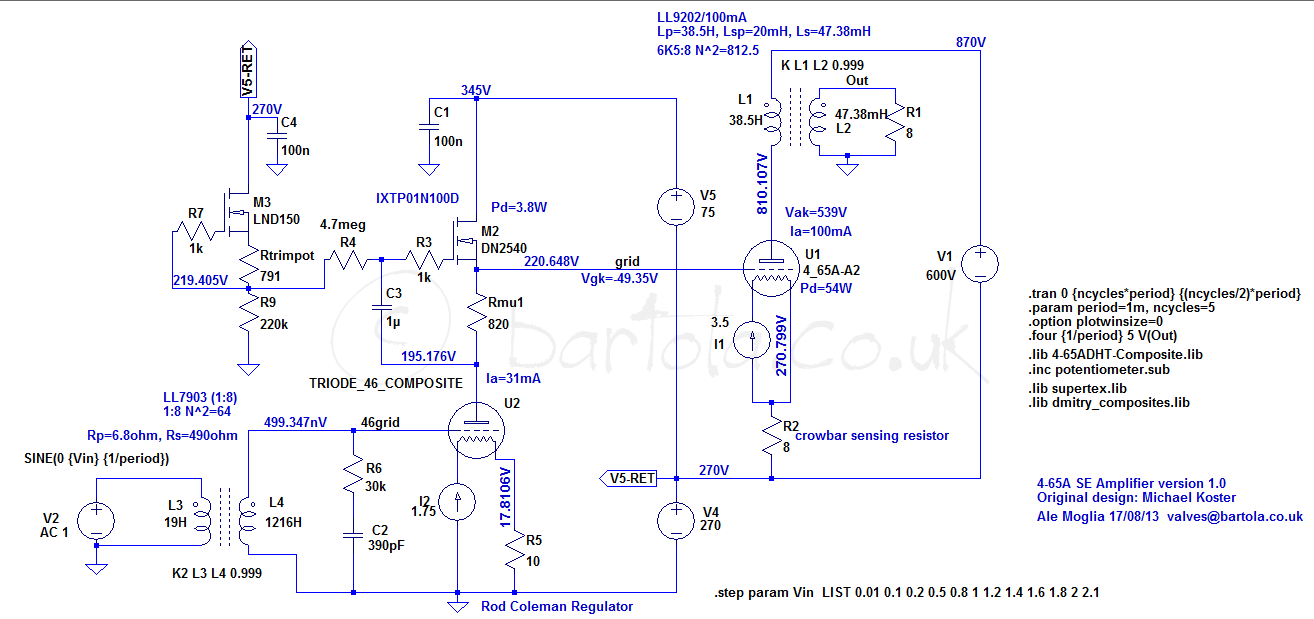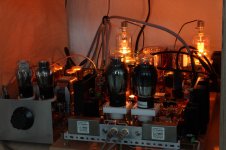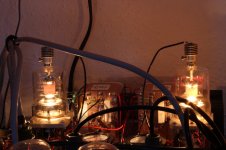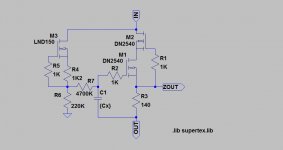I'm envisioning a need for diamonds...
Be careful...that only works a finite number of times in a lifetime before it becomes prohibitably expensive.....After 28 years of marriage I have used them all up!
Here's a slightly different version of the 833 schematic, using a gentle 3dB of local feedback to lower the output impedance and increase the damping factor a bit.
Full power is now 181W at 3.5V input...it will make my preamp feel more needed...
I think this is the one I'll build. Probably.
.
Full power is now 181W at 3.5V input...it will make my preamp feel more needed...
I think this is the one I'll build. Probably.
.
Attachments
Here's a slightly different version of the 833 schematic, using a gentle 3dB of local feedback to lower the output impedance and increase the damping factor a bit.
Full power is now 181W at 3.5V input...it will make my preamp feel more needed...
I think this is the one I'll build. Probably.
.
Turns out I can eliminate C3 from the above schematic without any harm...one less capacitor!
After some further optimization I've obtained the following output figures from the sim:
200Wrms at 2.5V input with 0dB feedback
192Wrms at 3.3V input with 3dB feedback
156Wrms at 4V input with 6dB feedback
Anything past that and the 6E5P runs out of steam.
My 26 preamp can easily supply the 4V needed, so that's not an issue. So it looks like I'll make it with switchable feedback and experiment to find which is best. Now just waiting for the iron...
2300V B+ ... scary!
Agreed. I plan to exercise the utmost caution both in assembly and use. For example, although heater supplies may be acceptably moved to a separate power supply unit depending on space considerations and hum, the ultra-HT will ONLY be in the amp chassis, so no umbilical electrocution cords will be used. I'd like to keep the path as short as possible within that chassis - Xfrmer to rectifier to chokes/caps/to 833 anode, with the appropriate high voltage wire of course. Double insulation in addition to safety earth grounding is a consideration as well. Of course the 833 will have a shield of some sort around it, most likely a ventilated tempered glass tube, to limit access.
I do not undertake this lightly, lest someone undertake me in short order.
4-65a SE Amp finished!
Glad to have reached the end of this long project. A fantastic amp built experience and so far I'm amazed with the performance of this amp. I've only listened to it no more than 2-3 hours. Need further burn-in, but I'm very happy with it!
My initial goal was an all DHT class A2 SE amp based on Michael's design. I ended up with a crazy idea of a 46 driver in filament bias. You realised it's crazy when you see the size of the power supplies. The investment paid off. The driver can do 200Vpp @ 0.09% running at about 35mA which provides a great driving capability to the 4-65a thanks to the mu-follower gyrator load.
What surprised me so far are the bass and dynamics of this amp. Clearly I wasn't used to having 10W of single-ended power, but know I can get more than the 2W of my 45 SE to play that music that needed a tad more power. I'm not playing it loud at all. So far I did a quick run through jazz (e.g. Coltrane, Mingus, Davis), classical and rock music to test some favourite songs to listen to subtle characteristics of the amp. I will probably make some further comments in the future but overall can say it has a deep bass, fantastic dynamics and sweet tone.
A remarkable note is the quietness of this amp. Can get no hum whatsoever on the FE167E speakers. See my THD measure below. All filaments are DC using Rod Coleman regulators (highly recommended) and not easy to achieve this with the 6V/3.5A heaters
here are some pictures if you are interested:
4-65a SE Amp: testing it finally! | Bartola Valves
And the 4-65A running cherry red to keep the getter healthy:
4-65a SE Amp: cherry anodes | Bartola Valves
I have some slight improvement to make to the Salas SSHV2 regulator which I will post on the other thread.
Special thanks to Michael Koster (design), Rod Coleman (regulators and crowbar protection help) and Thomas Mayer (transformers).
Thanks
Ale
Glad to have reached the end of this long project. A fantastic amp built experience and so far I'm amazed with the performance of this amp. I've only listened to it no more than 2-3 hours. Need further burn-in, but I'm very happy with it!
My initial goal was an all DHT class A2 SE amp based on Michael's design. I ended up with a crazy idea of a 46 driver in filament bias. You realised it's crazy when you see the size of the power supplies. The investment paid off. The driver can do 200Vpp @ 0.09% running at about 35mA which provides a great driving capability to the 4-65a thanks to the mu-follower gyrator load.
What surprised me so far are the bass and dynamics of this amp. Clearly I wasn't used to having 10W of single-ended power, but know I can get more than the 2W of my 45 SE to play that music that needed a tad more power. I'm not playing it loud at all. So far I did a quick run through jazz (e.g. Coltrane, Mingus, Davis), classical and rock music to test some favourite songs to listen to subtle characteristics of the amp. I will probably make some further comments in the future but overall can say it has a deep bass, fantastic dynamics and sweet tone.
A remarkable note is the quietness of this amp. Can get no hum whatsoever on the FE167E speakers. See my THD measure below. All filaments are DC using Rod Coleman regulators (highly recommended) and not easy to achieve this with the 6V/3.5A heaters
here are some pictures if you are interested:
4-65a SE Amp: testing it finally! | Bartola Valves
And the 4-65A running cherry red to keep the getter healthy:
4-65a SE Amp: cherry anodes | Bartola Valves
I have some slight improvement to make to the Salas SSHV2 regulator which I will post on the other thread.
Special thanks to Michael Koster (design), Rod Coleman (regulators and crowbar protection help) and Thomas Mayer (transformers).
Thanks
Ale
Attachments
Glad to have reached the end of this long project. A fantastic amp built experience and so far I'm amazed with the performance of this amp. I've only listened to it no more than 2-3 hours. Need further burn-in, but I'm very happy with it!
My initial goal was an all DHT class A2 SE amp based on Michael's design. I ended up with a crazy idea of a 46 driver in filament bias. You realised it's crazy when you see the size of the power supplies. The investment paid off. The driver can do 200Vpp @ 0.09% running at about 35mA which provides a great driving capability to the 4-65a thanks to the mu-follower gyrator load.
What surprised me so far are the bass and dynamics of this amp. Clearly I wasn't used to having 10W of single-ended power, but know I can get more than the 2W of my 45 SE to play that music that needed a tad more power. I'm not playing it loud at all. So far I did a quick run through jazz (e.g. Coltrane, Mingus, Davis), classical and rock music to test some favourite songs to listen to subtle characteristics of the amp. I will probably make some further comments in the future but overall can say it has a deep bass, fantastic dynamics and sweet tone.
A remarkable note is the quietness of this amp. Can get no hum whatsoever on the FE167E speakers. See my THD measure below. All filaments are DC using Rod Coleman regulators (highly recommended) and not easy to achieve this with the 6V/3.5A heaters
here are some pictures if you are interested:
4-65a SE Amp: testing it finally! | Bartola Valves
And the 4-65A running cherry red to keep the getter healthy:
4-65a SE Amp: cherry anodes | Bartola Valves
I have some slight improvement to make to the Salas SSHV2 regulator which I will post on the other thread.
Special thanks to Michael Koster (design), Rod Coleman (regulators and crowbar protection help) and Thomas Mayer (transformers).
Thanks
Ale
Ale,
Congrats on the job well done! I am curious as to know what capacitors you ended up using in the mu-follower coupling?
Regards,
-MW
Hi Michael,
Thanks, it doesn't look as nice as yours though!
Which cap do you mean? It's DC coupled so I guess you are refering to the gyrator cap? It's an 1uF/630V LCR one...
Ale
Yes, that is the one that I meant
-MW
Hi Michael,
I'm surprised with your findings. When I used the mu-follower gyrator in a preamp before never noticed a huge difference in sound. I only tried two versions of PIO caps so wasn't a very good test. Given the capacitor's role in the gyrator I'd thought the impact was minimum. Would be interested to hear your recommendations on brands/types here...
thanks
Ale
I'm surprised with your findings. When I used the mu-follower gyrator in a preamp before never noticed a huge difference in sound. I only tried two versions of PIO caps so wasn't a very good test. Given the capacitor's role in the gyrator I'd thought the impact was minimum. Would be interested to hear your recommendations on brands/types here...
thanks
Ale
4-65a SE Amp - minor adjustments
Here is my current schematics with the latest adjustments to the operating point and salas shunt regulator:

For the ones who are not familiar with Michael Koster's design, read all this thread. Basically I redesigned my driver using the 46 DHT in triode-mode and filament bias. A madness I know, but it sounds superb. It can swing 200-250Vpp easily. I measured less than 0.1% @200Vpp which is outstanding. The stepup is LL7903. The 46 can handle very easily the 4-65a valve in A1 and with the help of the 01N100D sufficient grid current is possible and the low impedance of the grid in A2 is managed very well by this mu-follower setup. The 4-65a cathode has a 200mA ammeter and a crowbar protection circuit. Is nice to see the ammeter needle to move with the music slightly when operating in A2 due to the grid current.
All filaments are heated with Rod Coleman's boards. This amp is extremely quiet. Can't get any traces of hum in my FE167E drivers. You can see some THD plots in my website.
As suggested by Michael I will try other types of capacitors for C3. Would be interesting to see what the impact is on sound as he highlighted, probably in LF. The bass of this amp is unique. I guess it also it matches better my full range driver.
The price of building this monster is worth every penny. It has a fantastic DHT sound with the power I couldn't get out of my 45. Not comparing, simply saying that it is really warm, sweet with impressive details. The bass and dynamic response is what surprised me the most. Been playing it for many days now and exploring well known records to discover new subtle colours in the tone and response.
More to follow...
Cheers,
Ale
Here is my current schematics with the latest adjustments to the operating point and salas shunt regulator:

For the ones who are not familiar with Michael Koster's design, read all this thread. Basically I redesigned my driver using the 46 DHT in triode-mode and filament bias. A madness I know, but it sounds superb. It can swing 200-250Vpp easily. I measured less than 0.1% @200Vpp which is outstanding. The stepup is LL7903. The 46 can handle very easily the 4-65a valve in A1 and with the help of the 01N100D sufficient grid current is possible and the low impedance of the grid in A2 is managed very well by this mu-follower setup. The 4-65a cathode has a 200mA ammeter and a crowbar protection circuit. Is nice to see the ammeter needle to move with the music slightly when operating in A2 due to the grid current.
All filaments are heated with Rod Coleman's boards. This amp is extremely quiet. Can't get any traces of hum in my FE167E drivers. You can see some THD plots in my website.
As suggested by Michael I will try other types of capacitors for C3. Would be interesting to see what the impact is on sound as he highlighted, probably in LF. The bass of this amp is unique. I guess it also it matches better my full range driver.
The price of building this monster is worth every penny. It has a fantastic DHT sound with the power I couldn't get out of my 45. Not comparing, simply saying that it is really warm, sweet with impressive details. The bass and dynamic response is what surprised me the most. Been playing it for many days now and exploring well known records to discover new subtle colours in the tone and response.
More to follow...
Cheers,
Ale
Hello Ale,
I'm adapting a variant of this scheme to my 833C 'Midlife Crisis" Amp. My custom OPTs and HV chokes just arrived at the airport in a 92kG crate according to the tracking data (yay!).
Just one question: why such a large cap in the gyrator/mu follower? You have a corner frequency of 0.03Hz when combined with the 4.7M +220K resistors. You could easily drop that to 0.22uF or even lower. Smaller caps usually sound better provided they achieve the required corner frequency, IMO, and they are cheaper, too!
I'm adapting a variant of this scheme to my 833C 'Midlife Crisis" Amp. My custom OPTs and HV chokes just arrived at the airport in a 92kG crate according to the tracking data (yay!).
Just one question: why such a large cap in the gyrator/mu follower? You have a corner frequency of 0.03Hz when combined with the 4.7M +220K resistors. You could easily drop that to 0.22uF or even lower. Smaller caps usually sound better provided they achieve the required corner frequency, IMO, and they are cheaper, too!
- Home
- Amplifiers
- Tubes / Valves
- Class A2 Direct MOSFET Coupled SE






